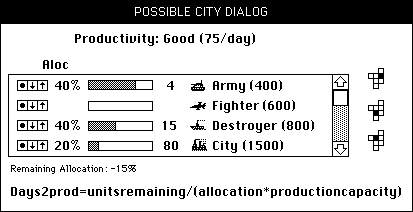
|
Alexander Cities will be able to produce additional city units in addition to the usual playing pieces. New city units must be placed on a square adjacent to the producing city. A landlocked city that expands to the sea will then be able to produce naval pieces.
Every undamaged city will possess a productivity rating of 100 man-hours per city unit. Thus, if an army requires 400 m.h., an undamaged single unit city can produce one army every four days. A two unit city could produce an army every two days. If a city sustains an attack, its productivity may fall with the result that it will take longer to produce new pieces. If productivity falls below 50 manhours, the city will fall. A damaged city will automatically regenerate itself until it regains full productivity. Instead of choosing only one piece to be produced per city, Alexander generals have the option of dividing available manhours so as to produce several pieces simultaneously. A dialog box will allow generals to set allocations and view estimates of days-to-completion for each piece under construction.
New pieces can be placed in any grid within a multi-grid city. Mobile pieces can move from any part of the city to any other part in one day. They can also move from any part of the city to any grid adjacent to the city in one day. Since a one unit bomb will only take out a single city grid, the position of pieces within the city can be important. Cities will play an important role in combat situations. Certain pieces, like fighters, may have their defensive rating reduced when "parked" in a city. Other pieces, like armies, may benefit when defending from within a city. |

